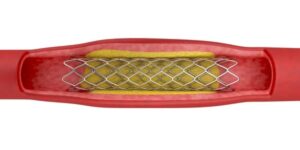Stent Placement
Peripheral artery disease is a common circulatory problem where vessels that carry blood from your heart to the rest of your body become narrowed or blocked. This means there is not enough blood flowing to your extremities. Treatment for PAD is usually lifestyle changes and medication. In some cases, it may be necessary to undergo a procedure called an angioplasty.

What is a Stent?
A stent is a wire mesh “scaffold” that is permanently implanted in the artery to keep it open. It is usually combined with angioplasty to treat PAD.
How is it placed into your Artery?
Stent placement is a minimally invasive procedure that is done in an outpatient setting. Medication is given through an IV in your arm to help your relax or put you in a twilight sedation throughout the procedure. An angiogram will be performed and it is when an Interventional CaradioVascular Specialist, Interventional Radiologist or Vascular Surgeon puts a small tube called a catheter into your artery.
Once the catheter is in place, the doctor guides the catheter to the area of narrowing or blockage. A contrast is injected into your artery in order to visualize the blood flow with the use of x-ray at the same time.
The area that is narrowed or blocked is ballooned to compresses the plaque against the artery walls. A stent is then put in this area and the balloon is once again inflated to expand the stent to the artery walls.
The stent helps hold open the artery so that blood can flow to the lower extremities.
Recovery Time
Recovery from a stent placement is only a few short hours at Vascular Institute. You will be monitored closely and then able to go home. It will be recommended to rest the remainder of the first day. You will have some lifting and activity restrictions for up to 5 days.
During this recovery period, you may experience mild soreness, bruising and/or discoloration of the skin where the artery was punctured and the catheter was inserted.
You will be sent home with discharge instructions after the procedure on specific instructions to follow. After the placement of a stent, your doctor will recommend that you take Aspirin 81 mg every day and another medication called Plavix.
Aspirin helps to thin your blood and Plavix is given to help prevent the build up of plaque on the stent that was placed.


